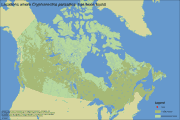Chestnut blight

- Latin : Cryphonectria parasitica (Murrill) Barr
- English: Chestnut blight
- French: Brûlure du châtaignier
- Subdivision: Ascomycota
- Order/Class: Diaporthales
Description
Distribution
Micro-habitat(s)
Trunk
Damage, symptoms and biology
Because the cankers caused by the fungus prevent sap circulation, the disease symptoms include leaf yellowing, followed by leaf withering above the cankered parts. In unusual circumstances, the withered leaves may cling to the branches until late fall.
Comments
As its name suggests, this disease primarily attacks various species of chestnuts, of which only one, the American chestnut (Castanea dentata ), is indigenous to Canada. This species is yet considered an endangered species according to the Species at Risk Act (SARA), because of the impact of chesnut blight, a disease introduced from Asia. It has been found first in the early 1900's in Eastern United States. In Canada, the disease has been noticed in Southern Ontario and on a few ornamental chestnuts planted in British Columbia.The disease, which originated in Europe and was introduced into Canada in the early 1900s, has made the American chestnut, found only in the area north of Lake Erie, an endangered species. Nowadays, the few rare trees that survive chestnut blight are often offset by numerous cankers or originate from coppice, growing no higher than 10 metres, whereas American chestnut trees used to grow to 35 metres in height and 1 metre in diameter. Chestnut trees were a significant, widespread component of mature forests in eastern North America. It should be noted, as well, that the pathogen can survive as a saprophye on some other host such as oaks, red maple and shagbark hickory.
Sources:
Sinclair, W.A. and Lyon, H.H. 2005. Diseases of trees and shrubs - Secon d edition. Comstock Publishing Associates, Cornell University Press, Ithaca, New York, 660 pp.
Abgrall, J.F. et Soutrenon, A. 1991. La forêt et ses ennemis. CEMAGREF, Grenoble, 399 p.
Information on host(s)
Main host(s)
American chestnut
